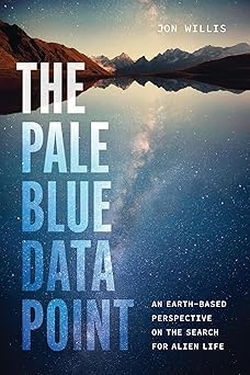Centauri Dreams
Imagining and Planning Interstellar Exploration
A Three Part Model for Jupiter’s Formation
Meteorites have proven a useful tool for probing the nature of the early Solar System. Although I missed it at the time, Thomas Kruijer (University of Münster) and colleagues announced results last year from their study of the age of Jupiter based on measuring isotopes in meteorites. The age of Jupiter is an open question, but because current formation models have gas giants forming large solid cores and then rapidly accreting gas, the assumption is that the circumstellar disk could not have been depleted of its gas by the time Jupiter’s formation was complete.
A gas giant must form, in other words, fairly rapidly, and the Kruijer paper offered a deeper look into the conditions of the surrounding disk during the process. The researchers were able to identify “…two genetically distinct nebular reservoirs that coexisted and remained spatially separated between ~1 My and ~3-4 My after Solar System formation.” Even that early in the formation of the Solar System, two bands of relatively small bodies had emerged.
We can imagine Jupiter growing and becoming the blocking factor between the inner and outer parts of the circumstellar disk. The idea has triggered further work from Yann Alibert (University of Bern), working with a team of researchers from both the University of Zürich and ETH Zürich, who delve into a gas giant formation model that adds considerable detail to older concepts.
A Jupiter growing from 20 to 50 Earth masses would explain the Jupiter ‘barrier,’ for it would create a higher density of dust that could trap pebbles outside its orbit. The separation would remain for a time because only when the planet grew large enough would it reach the amount of mass necessary to perturb pebbles, rocks and other debris inward, thus mixing the regions.
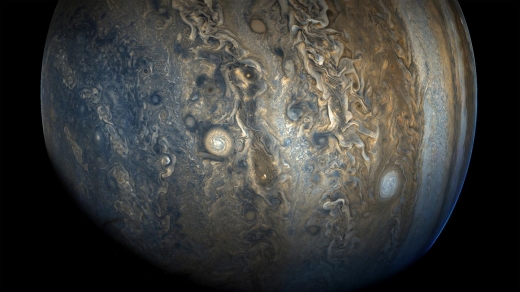
Image: Jupiter’s southern hemisphere photographed by NASA’s Juno spacecraft. Credit: NASA/JPL-Caltech/SwRI/MSSS/Gerald Eichstaedt/Sean Doran.
What Alibert and team didn’t like was the timing, which the meteorite data indicated was a two million year window. “How could it have taken two million years for Jupiter to grow from 20 to 50 Earth masses?” asks Julia Venturini (University of Zürich). A good question, and one from which the Alibert study grew. Out of this dissatisfaction has emerged a three-part model based on the idea that different kinds of bodies contribute mass and energy as the planet forms.
What we have lacked before now is an idea of the size of the accreting materials. In the Alibert model, the process works like this: Growth of the planetary embryo begins by accreting pebbles at the centimeter scale, building a core during an initial period lasting about 1 million years. A period of slower accretion — this time of rocks at kilometer size, or planetesimals — now follows. This period lasts 2 million years, and accounts for the period that turns up in the Kruijer meteorite studies.
As planetesimals strike the young, growing planet, they impart heat and energy. Says Alibert: “During the first stage the pebbles brought the mass: In the second phase, the planetesimals also added a bit of mass, but what is more important, they brought energy.”
This energy is crucial to the model, because it heats the atmosphere of the infant Jupiter enough to prevent contraction as well as further gas accretion. This delay in gas accretion allows slow the growth from 20 to 50 Earth masses and fits nicely with the meteorite data. It explains why the time the planet spent in this mass range was so unexpectedly long.
In 3 million years, Jupiter reaches 50 Earth masses, and at this point, the third phase of formation can occur, dominated by runaway gas accretion and building toward a planet that is what we see today, a giant of 300 Earth masses. Jupiter could be said, then, to have had a period of ‘arrested development’ as kilometer-sized blocks injected high energy, slowing the accretion of gas. Small pebbles build a core, planetesimals provide heat that delays gas accretion, which finally takes off as the planet cools and swells toward its current size.
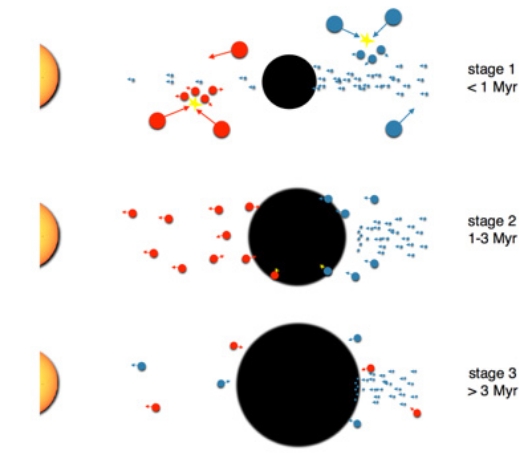
Image: This image shows the formation of Jupiter in 3 stages. Stage 1 / until 1 million years: Jupiter grows by accretion of pebbles (blue dots). Large primordial planetesimals (big red dots) show high collision velocities (red arrows) leading to destructive collisions (yellow) and producing small, second generation planetesimals (small red dots). Stage 2 / 1-3 million years: The energy resulting from the accretion of small planetesimals prevents rapid gas accumulation and thus rapid growth (gray arrows). Stage 3 / beyond 3 million years: Jupiter is massive enough to accrete large amounts of gas. Credit: UniBE.
This multi-phase hypothesis for gas giant formation explains how the division between inner and outer Solar System found so early in the data could arise during the 2-million year window, and also explains why the growth rate could be so slow. From pebbles to planetesimals, the new gas giant theory could offer insights as well into exoplanet formation. But will it fit other planets in our own Solar System? Applying these concepts in particular to Uranus and Neptune should be interesting, but Alibert and team think the data fit. We should see future work on the idea.
The paper is Alibert et al., “The formation of Jupiter by hybrid pebble-planetesimal accretion,” Nature Astronomy 27 August 2018 (abstract). The Kruijer paper is “Age of Jupiter inferred from the distinct genetics and formation times of meteorites,” Proceedings of the National Academy of Sciences Vol. 114, Issue 26 (June, 2017). Abstract.

OSIRIS-REx: Looking Forward & Looking Back
The OSIRIS-REx spacecraft carries three cameras as it makes its way to the asteroid called Bennu, a suite that is collectively known as the OSIRIS-REx Camera Suite (OCAMS). So now we’re into the realm of OSIRIS-REx acronyms, and these should become familiar in coming months just as New Horizons’ instruments like LORRI (Long Range Reconnaissance Imager) and PEPSSI (Pluto Energetic Particle Spectrometer Science Investigation) did enroute to Pluto.
The camera called PolyCam is responsible for the image below, an animation showing the target acquired on August 17, at a distance of 2.25 million kilometers. PolyCam will serve as a reconnaissance camera as the spacecraft nears Bennu, but its other role is that illustrated here, as a long-range acquisition camera whose first visual of the target has been in the works for nine weeks. That’s the length of the planning process, testing, reviews and code upload.
“Right now, Bennu just looks like a star, a point source,” said Carl Hergenrother, UA Lunar and Planetary Laboratory staff scientist and OSIRIS-REx astronomy working group lead who proposed Bennu as the mission target during the early planning phase when the asteroid was simply known as 1999 RQ36. “That will change in November, when we will begin detailed observations and we’ll start seeing craters and boulders. You could say that’s when our asteroid will transition from being an astronomical object to an actual geological object.”
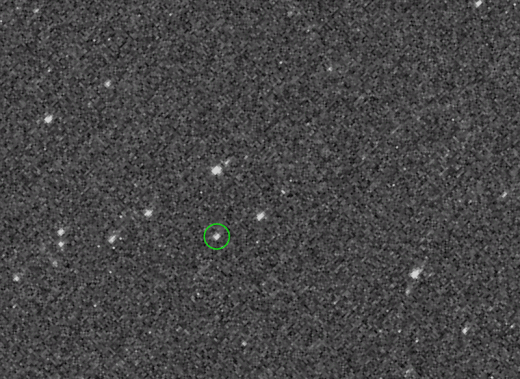
Image: For this animation, OSIRIS-REx image scientists combined five exposures of asteroid Bennu taken by the spacecraft’s PolyCam camera. At this distance, almost six times of that between the Earth and the moon, Bennu is just a point source, indistinguishable from a star other than the way it moves against the star field in the background. This will change dramatically once the spacecraft comes closer and makes its rendezvous with the asteroid in December. Credit: NASA/Goddard/University of Arizona.
We’re 98 days from arrival at Bennu on December 3. OSIRIS-REx controllers will be increasingly busy as the approach phase intensifies, as a glance at the approach activities shows. Here’s what’s ahead during this period, as presented in an LPL news release:
- Regularly observe the area around the asteroid to search for dust plumes and natural satellites, and study Bennu’s light and spectral properties;
- Execute a series of four asteroid approach maneuvers, beginning on Oct. 1, slowing the spacecraft to match Bennu’s speed and trajectory;
- Jettison the protective cover of the spacecraft’s sampling arm in mid-October and subsequently extend and image the arm for the first time in flight;
- Use OCAMS to reveal the asteroid’s overall shape in late October and begin detecting Bennu’s surface features in mid-November.
As for the rest of those acronyms beyond the OCAMS camera suite, we will be hearing more and more about a thermal spectrometer (OTES), the OVIRS visible and infrared spectrometer, the OLA laser altimeter and the REXIS X-ray spectrometer. On the OSIRIS-REx acronym itself, we can untangle it this way: Origins Spectral Interpretation Resource Identification Security Regolith Explorer.
Quite a mouthful, but it does condense the mission goals: To return a sample of a carbon-rich asteroid, define its properties, identify its chemistry and mineralogy, measure the Yarkovsky Effect on nearby asteroids (caused by uneven heating on a rotating asteroid, and capable of changing an asteroid trajectory), and document the morphology, geochemistry and spectral properties of the surface material. Along the way, we’ve already had some spectacular views.
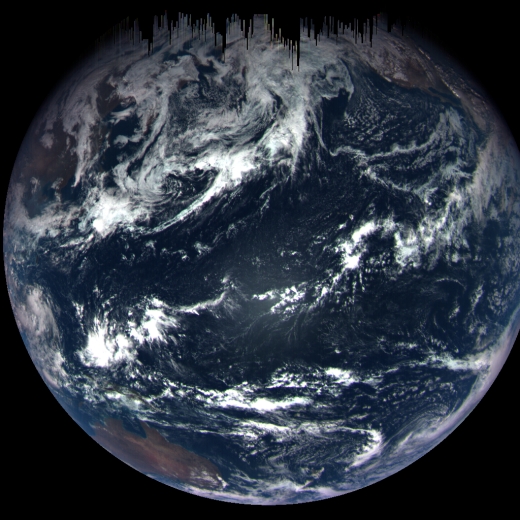
Image: A color composite image of Earth taken on Sept. 22 by the MapCam camera on NASA’s OSIRIS-REx spacecraft. This image was taken just hours after the spacecraft completed its Earth Gravity Assist at a range of approximately 170,000 kilometers. MapCam is part of the OSIRIS-REx Camera Suite (OCAMS) operated by the University of Arizona. Visible in this image are the Pacific Ocean and several familiar land masses, including Australia in the lower left, and Baja California and the southwestern United States in the upper right. The dark vertical streaks at the top of the image are caused by short exposure times (less than three milliseconds). Short exposure times are required for imaging an object as bright as Earth, but are not anticipated for an object as dark as the asteroid Bennu, which the camera was designed to image. Date Taken: Sept. 22, 2017. Instrument Used: OCAMS (MapCam). Credit: NASA/Goddard/University of Arizona.
The peoples of the ancient Nile delta saw the Egyptian god Osiris as being behind the spread of agriculture, therefore considering this deity to be a bringer of life. Thus the determination to come up with the name OSIRIS in this mission. After all, OSIRIS-REx will be returning samples of the kind of asteroid that may contain organics. Ultimately, the origin of life on our planet may be tied into delivery of materials from such asteroids, so the name seems appropriate.
Bear in mind that for all its interest, Bennu is a tiny world, no more than 500 meters in diameter. That will make Bennu the smallest object ever orbited by a spacecraft. OSIRIS-REx will map the asteroid in its first month after arrival, allowing for the first direct measurement of its mass. Sample collection is scheduled to begin in early July 2020, with the spacecraft returning to Earth to eject its Sample Return Capsule for a landing in the Utah desert in September, 2023.
“The story of this asteroid is the story of the solar system,” says OCAMS instrument scientist Bashar Rizk. “When we understand Bennu, we will understand something fundamental about our solar system.”
Meanwhile, we continue to monitor the Japanese Hayabusa 2 spacecraft, which arrived at asteroid Ryugu in late June, and on which controllers have chosen a landing site. The spacecraft’s lander, the Mobile Asteroid Surface Scout (MASCOT), is scheduled to touch down on October 3 as part of the sample-return mission. More on Hayabusa 2 soon as we continue the exploration of near-Earth objects not only for the insights they give us into the early Solar System but also their potential for resource extraction and our need for planetary protection.

GW170817: An Extragalactic SETI Opportunity?
While we pursue SETI by listening to and looking at nearby stars within our own galaxy, the possibility of going extragalactic remains. Consider the activity at Penn State, where Jason Wright and colleagues Matthew Povich and Steinn Sigurðsson have been conducting the Glimpsing Heat from Alien Technologies (G-HAT) project, looking at infrared data from both the Wide-field Infrared Survey Explorer mission (WISE) and the Spitzer Space Telescope. An unusual infrared signature could conceivably be a sign of waste heat from such a culture.
Turning up the signature of a Kardashev Type III civilization, one capable of tapping the energy output of an entire galaxy, would be a spectacular find, a search well worth continuing. But there are other ways of looking for evidence that might fit what Wright has written about in terms of ‘Schelling points.’ The idea is to draw on game theory to analyze a situation in which two players who cannot communicate are engaged in a cooperative activity. They are, perhaps, asking themselves questions like when to transmit to a given target and in which directions to listen.

Thus we look at SETI as a mutual activity, and the game theory analyzed by the American economist Thomas Schelling comes into play. Wright looks at this in a paper called “Exoplanets and SETI” (citation below), noting that one of Schelling’s examples is particularly germane to SETI: Imagine you find yourself in a large city and are looking for someone who is also looking for you. Let me quote Wright on this:
Guessing the times and places to meet in the city, and guessing the frequencies to tune to in radio SETI, are superior strategies to random ones. In the city, this might include the locations of famous landmarks and times that bells chime or other coordinated actions occur; in radio SETI this might mean astrophysically significant frequencies and their multiples. Makovetskii (1980) called this a “mutual strategy of search” for “synchrosignals”(Makovetskii 1977), and Filippova et al. (1991) described this concept as a “convergent strategy of mutual searches” for SETI (both apparently unaware of Schelling’s prior art).
Image: Nobel Prize-winning economist and arms control theorist Thomas Schelling (1921-2016). Credit: Harvard University.
It is clearly useful to identify Schelling points when thinking about where to observe if we are looking for a SETI signal. We started SETI off back in the Project Ozma days by looking for Sun-like stars that might host habitable planets like our own, and we have target lists for continuing searches today. Would ETI do the same? The ecliptic might be a good place to look for a signal because Earth would transit the Sun from the viewpoint of astronomers around distant stars there. Another Schelling point: Exoplanet transits, which could be considered a communications window for any civilization deliberately trying to draw our attention.
Notice that these Schelling points assume a civilization that is attempting to be found, which is what Yuki Nishino and Naoki Seto (Kyoto University) do in a paper that extends Schelling to other galaxies. Whereas finding waste heat from a Type III civilization would assume no intent to communicate, Nishino and Seto ask whether there are any windows that an ETI culture might choose if it wanted to announce its presence to another galaxy. Given the challenge of the distances involved, such a signal would have to be sent at an obvious Schelling point.
Let’s leave aside the unknowable issue of motives (who knows why an alien species might want to broadcast its existence to beings in a culture millions of light years away?), and ask whether there are any obvious Schelling points that civilization might choose. The authors go through the literature, finding proponents of synchronizing signals via supernovae or gamma rays bursts, but here they question the timing accuracy involved and doubt the utility of the concept.
But the researchers argue that there is one natural phenomenon that could be forecast well enough in advance to allow a civilization to synchronize a signal: A binary neutron star merger. They point to the detection by the LIGO-Virgo network of a gravitational wave from the binary neutron star (BNS) system GW170817. Soon after the detection, the host galaxy NCG4993 was identified by electromagnetic observations, at a distance of ~40 Mpc. Nishino and Seto believe that a sufficiently advanced civilization could predict such a merger with high accuracy:
These Galactic BNSs contain recycled pulsars as one of the binary components, allowing high-precision measurements of the binary parameters. If ETI can detect the recycled pulsar of an inspiraling BNS system in their galaxy, they can also make a high-precision measurement for the quantities required for the signal transmission to be synchronized with the BNS merger. This synchronization scheme seems reasonable to us as a signal receiver…
A natural event lights up in a way sure to draw the attention of astronomers in other galaxies. A signal timed to coincide with it is sent to take advantage of the attention it has created.
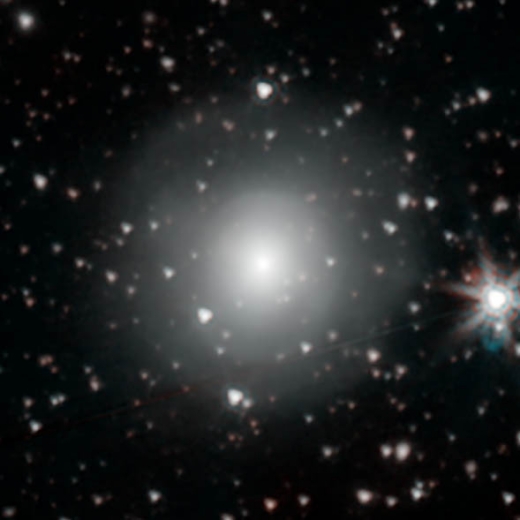
Image: NASA’s Spitzer Space Telescope has provisionally detected the faint afterglow of the explosive merger of two neutron stars in the galaxy NGC 4993. The event, labeled GW170817, was initially detected nearly simultaneously in gravitational waves and gamma rays, but subsequent observations by many dozens of telescopes have monitored its afterglow across the entire spectrum of light. Spitzer’s observation on September 29th comes late in the game, just over 6 weeks after the event was first seen, but if this weak detection is verified, it will play an important role in helping astronomers understand how many of the heaviest elements in the periodic table are created in explosive neutron star mergers. This image is a color composite of the 3.6 and 4.5 micron channels of the Spitzer IRAC instrument, rendered in cyan and red. The faint light from the explosion is to faint to be easily seen mixed in the light of the other stars in the galaxy. Credit: JPL/Caltech.
Thus we have a mechanism for creating a targeted signal that could announce the existence of a civilization to another galaxy, for whatever purposes it chose to do this. The detection of the cataclysmic binary neutron star merger would be accompanied shortly thereafter by a communication signal meant to be detected by astronomers studying the merger event itself. The authors estimate that a 1 terawatt transmitter in a galaxy 130 million light years away could send 10 megabytes of data to a receiver like the Square Kilometer Array.
The odds of a civilization choosing to deploy such methods seem long indeed, but it fascinates me to see that gravitational wave astronomy is now beginning to work its way into the SETI discussion. Thus the authors discuss the synchronization of the signal:
… the ETI would be able to estimate the location and the epoch of the highly energetic event in advance. Most optimistically, we might actually find an artificial signal by reanalyzing the electromagnetic data already taken from GW170817. Additionally, the LIGO-Virgo network will start the next observational run in early 2019, and a new BNS merger might be identified. The early and deep radio observation for its host galaxy might also be worth considering from the perspective of SETI.
The authors also note that to demonstrate the synchronization of the signal (i.e., to show that it was not a coincidence), the extraterrestrial civilization might include the intrinsic information of the particular binary neutron star merger involved. It’s an ingenious notion that extends directed beacon signals into the extragalactic realm and one that also calls into question the issue of galactic gravitational lensing. In any case, the transmitting culture is adjusting the timing and direction of its transmissions to coincide with the arrival of the gravitational wave signal.
Given the year-long observations of the GW170817 afterglow, Nishino and Seto argue that the difference between the arrival time of the GW signal and the artificial signal should be in the range of one year. Thus a transient, flaring phenomenon drawing our attention could become the announcement of a SETI opportunity, with a binary neutron star merger the brightest transient that can be predicted sufficiently in advance for the signal to be prepared.
Thomas Schelling, it goes without saying, never dreamed his work on game theory might be turned to extragalactic SETI, but the exercise of defining observational windows will continue.
The paper is Nishino and Seto, “The Search for Extra-Galactic Intelligence Signals Synchronized with Binary Neutron Star Mergers,” The Astrophysical Journal Letters Vol. 862, No. 2 (1 August 2018). Full text. The paper by Jason Wright is “Exoplanets and SETI,” available as a preprint.

The Gift of Fire
Humans are associative creatures, and it always amazes me how a single image or a particular scent can call up a memory on some completely different topic. Some associations are general: Most people associate Strauss’ magnificent Thus Sprach Zarathustra with Kubrick’s 2001: A Space Odyssey because of that movie’s spectacular opening sequence. For me, those powerful sounds likewise recall Apollo. Never forget that in April of 1968, we were getting ready for the first manned Apollo test, followed in almost bewilderingly short order by the grandest voyage then imaginable, the Apollo 8 circumnavigation of the Moon.
I always tie 2001 with Apollo and hear the Strauss in my mind whenever I think about Lovell, Borman and Anders reading so powerfully from Genesis that Christmas Eve. Reading Jeffrey Kluger’s brilliant Apollo 8 (Henry Holt, 2017) triggered the whole melange of memories and emotions. I’m sure people of a previous generation had their own deep associations when they heard about Lindbergh landing in Paris (Lindbergh, by the way, visited the Apollo 8 crew the night before the flight, and I sometimes wonder what kind of mental triggers went off in his mind when talking to these pioneers of another kind of voyaging).
Apollo 13 has its own associations, of bitter coffee as I sat compulsively re-reading newspaper articles the morning after the emergency had been made public, trying to take it all in. I was in a college student union and the coffee was terrible, but I just kept drinking it without noticing. God only knows how much coffee I drank, but I can tell you that a caffeine jag on truly terrible brew certainly didn’t help my mood that day in 1970. I love coffee, but it had better be fresh.
I have powerful associations with all the major space missions I’ve followed or written about, whether manned or unmanned. Voyager at Neptune makes me think of an owl outside the house late one night in 1989 as I tried to keep pace with live coverage of the encounter (much harder then than now, although as I recall PBS was on all night). Cassini surviving transit near the rings to go into Saturn orbit will always trigger memories of standing on a deck in a small midwestern house pointing out the planet to a young boy, the son of a friend, and all of us quietly looking at it with the thought that something human was now circling it.
Landing on Titan? I was totally wired when word came that the Huygens probe was descending under its parachute, a long, slow fall to an enigmatic surface. I had Lee Morgan’s ‘Sidewinder’ album on, a classic from a jazz trumpeter who died all too early (shot by his ex-wife in a jazz club!). I can’t hear Morgan’s riffs or the fine coloration of Billy Higgins’ drums without thinking of human technologies descending through Titanian haze, an exultant, frenetic energy. Associations like these are anything but rational; they’re more like a kind of internal jazz.
All this is in my mind because I was looking through the New Horizons site at the natural color images of Pluto and Charon that JHU/APL released at the end of July. Now New Horizons is an easy one. In my house growing up, there was an old encyclopedia — I can’t recall the publisher, though it wasn’t a common name, certainly not Britannica. The set predated Clyde Tombaugh and there was no Pluto to be found. I kept seeing the entry in that encyclopedia for ‘Solar System’ as New Horizons closed in on Pluto/Charon, and I could smell the rich mustiness of old, heavy paper and bound books rarely opened, a scent with its own kind of intoxication.
That scent is tangible to me as I look at the images below, showing the two worlds New Horizons so remarkably revealed. I wonder what associations Clyde Tombaugh might have had if he could have experienced the flyby from Earth (rather than ‘participating’ in it in the form of a small portion of his ashes being aboard the spacecraft). Would he see Kansas wheat waving in moonlight as he set up one of his telescopes as a boy? Or perhaps feel a desert wind around Lowell Observatory as he recalled taking time off from his work on the blink comparator?
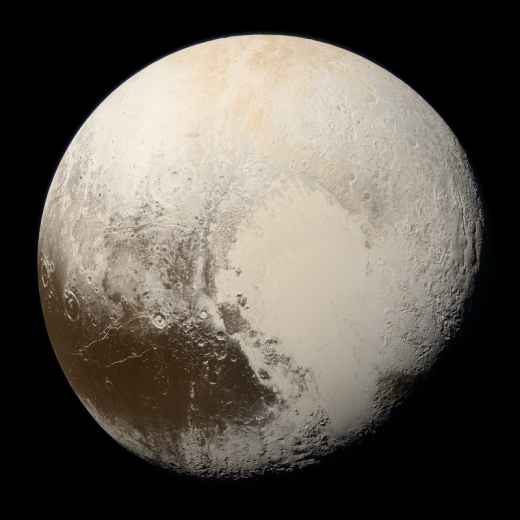
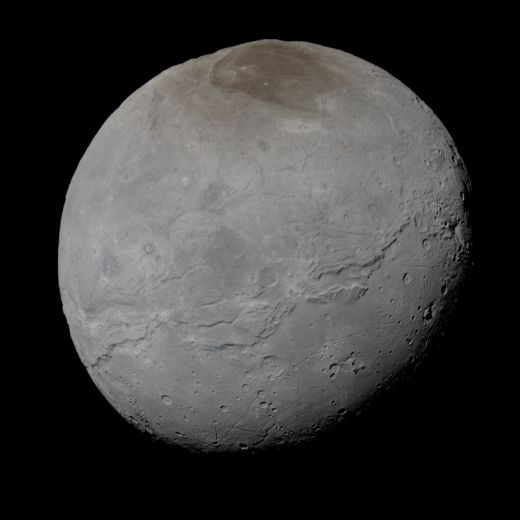
Image: These are the most accurate natural color images of Pluto (top) and its largest moon, Charon (bottom), taken by NASA’s New Horizons spacecraft as it approached the Pluto system on July 14, 2015. Each is a single color scan from the New Horizons Multispectral Visible Imaging Camera. The images here are not to scale; with a diameter of 2,370 kilometers, Pluto is about twice the size of Charon (1207 kilometers). Credit: NASA/Johns Hopkins University Applied Physics Laboratory/Southwest Research Institute/Alex Parker.
No one can predict what kind of memories will stick. The great essayist Michel de Montaigne devalued memory, which was highly prized throughout the European Renaissance. He relied instead, he tells us, on good judgment as the most important part of the human intellectual toolkit. I can’t agree, because for me, good judgment is inextricably bound up with memory. We are both what we learn and what we experience, the two tangled and woven into each other. In any event, New Horizons hit me emotionally and hard not purely because of the scientific return but also because it recalled years of growing up and wondering about Pluto.
We are, as Richard Feynman might have said, the sum of all our histories.
Now we prepare for the flyby of MU69, the object called Ultima Thule, on January 1 of the coming year, with the New Horizons team already readying the spacecraft for the encounter. The spacecraft is now in 3-axis mode, transitioning from spin mode on August 13. We’re 90 percent of the way from Pluto to the KBO as we prepare for the farthest exploration of any planetary body in history.
That’s the thing about space exploration. Not limited like the early sailing vessels to moving about on a finite sphere, we can hope to find something new in almost any direction as we push outward and keep going. We’re coupling digital technologies with human resourcefulness spiced by the kind of dreaming of the unknown that has inspired voyages of all kinds for centuries.
Inevitably, MU69 will trigger its own set of associations because we can’t stop the process even if we wanted to. We humans make memories like oysters make pearls, and memories shape character. Years ago I bought Michael Collins’ book Carrying the Fire in a Sun-flooded Missouri bookstore. Which reminds me of Plutarch, who said, “The mind is not a vessel to be filled. It is a fire to be ignited.” That’s a conflagration that is not easily smothered.
If we have the sense to keep going, there will always be new targets. There will always be new ways to study and explore them. There will always be fire to be gifted to our children.

A ‘Flyby’ Model for Early Solar System Evolution
How close would a passing star have to come to produce drastic results on the outer Solar System? According to researchers at the Max Planck Institute for Radio Astronomy in Bonn, roughly 3 times Neptune’s distance would be disruptive enough to explain what we see beyond that planet’s orbit today. Led by Susanne Pfalzner, the scientists have been modeling close stellar flybys of other planetary systems for years, but have only recently turned their attention to the eccentricities of our own system, where conditions beyond Neptune pose questions.
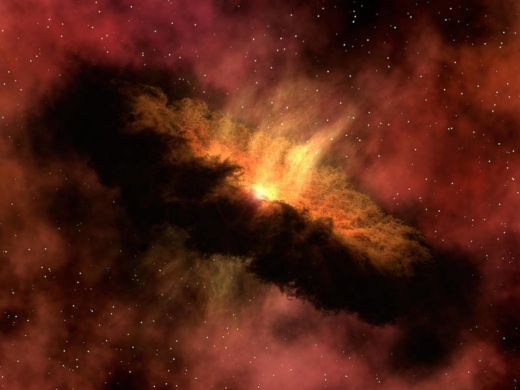
Image: Artist’s concept of a stellar system in the making with a protoplanetary disk surrounding a young star. Credit: NASA JPL-Caltech.
A look at the Solar System’s formation highlights the problematic nature of the process. Out to the orbit of Neptune, planets, dwarf planets and asteroids orbit with only small differences in orbital inclination, indicative of the flatness of the original disk from which all these objects drew their birth materials. But we find that many trans-Neptunian objects move along eccentric, inclined orbits, with objects like Sedna occupying orbits well outside the range of the planets.
What Pfalzner and team added to the mix was another observation: In this distant region, the cumulative mass of the objects we know about drops by almost three orders of magnitude. The assumption is that the outer Solar System must have been modified by processes that took place after its formation. The fact that the drop-off occurs just outside Neptune’s orbit provoked enough interest that the scientists began to perform computer simulations, starting with a young circumstellar disk around the Sun and introducing the close passage of another star.
The result is striking. A star of 0.5 to 1 solar masses moving past our outer system would produce a good fit for the current Solar System, and as we’ll see, in more ways than one:
Starting point of our simulations was the Sun surrounded by a disc, which could either be a protoplanetary or a debris disc, possibly containing already formed planets. We performed an extensive parameter study for the effect of close flybys on discs concentrating on the ones that lead to a steep drop in the mass distribution at 30-35 AU as that observed for the solar system. We found that fly-bys of stars with masses in the range 03.-1.0 M at perihelion distances of between 50 and 150 AU inclined between 50 to 70 degree and at an angle of periastron between 60 to 120 degree are the most promising candidates for a fly-by shaping the outer solar system. Such fly-bys lead to Sednoids, a hot and cold Kuiper belt population and various other properties characteristic for the outer solar system. What distinguishes this model from others, is that only a single event is necessary to create all this features.
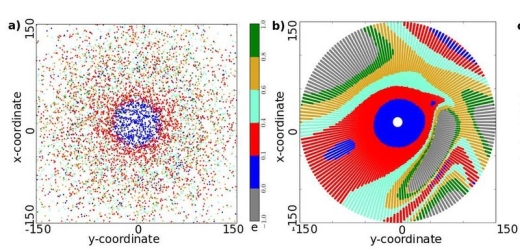
Image: Simulation of the stellar intruder scenario for a mass of 0.5 solar masses and a perihelion distance of 100 astronomical units or 15 billion kilometers for the perturbing star (three times the distance between Sun and Neptune). a) average positions of the particles after the fly-by, colors showing eccentricity of their orbits increasing from blue to green. b) particle positions before the fly-by with different eccentricity populations (colors) from the top row Grey regions: particles that became unbound due to the fly-by event. Credit: S. Pfalzner et al.: The Astrophysical Journal (2018).
As the paper notes, a virtue of this model is its simplicity, allowing a single event (the close flyby) to explain a multitude of features about the current system. For there is another puzzle to be explained: The separation between the giant planets around the Sun increases as their mass decreases with distance from the Sun, which is usually considered to reflect conditions in the protoplanetary disk. But Neptune, with a mass of 17.2 Earths, is more massive than Uranus, at 14.6 MEarth.
The Pfalzner paper explains this, for in its flyby simulations, some portion of the matter beyond Neptune moves inward and concentrates between 30 and 35 AU. In fact, the matter involved corresponds to approximately 1-2 Earth masses, pointing to the possibility that Neptune grew from the incoming material to its present disproportionate size. Some other models have suggested that Neptune and Uranus were originally positioned in opposite order than today and moved to their present positions by gravitational instabilities, an idea the flyby model discounts.
A final note is that the so-called ‘cold Kuiper Belt,’ made up of objects that move on fairly circular, low-inclination orbits, does not fit well with any current planet-scattering models, while it does fit within the parameters of the stellar flyby simulations. Moving to the realm of prediction, these simulations make it clear that if the flyby scenario is correct, many additional outer system bodies at high inclinations may yet be found, perhaps including an object of planetary mass.
Recently we looked at Omega Centauri a cluster whose dense composition caused researchers to question habitability given that planetary orbits were so likely to be disrupted by encounters with other stars. It’s worth remembering that stars like the Sun were born in large groups of stars that were originally densely packed, making stellar encounters more likely.
The numbers from subsequent simulations performed by these researchers are interesting, showing that the odds on such an encounter were fairly high:
Performing simulations of the dynamics of star clusters – gas expulsion, expansion and finding a new quasi-equilibrium – we find that such type of fly-bys are probable not only during the early phases but also on Gyr time scales, with a 5-7% chance of all solar-type stars experiencing such a fly-by during the first 10 Myr and a 20-30% chance in the next Gyr. If planet formation is as fast as anticipated from the ring structures in some discs, even a fly-by during the first 10 Myr would be an option. We showed that the probability of such an event even in the consecutive 4.56 Gyr is competitive to that of other models.
Thus we have an alternative to the ‘Nice Model’ and its offshoots for early Solar System formation, one that manages to explain multiple features of the outer system through a single event rather than a series of gravitational encounters. Calling it a ‘realistic alternative’ to present models, Pfalzner points out that it remains a hypothesis, but one intriguing in its simplicity.
The paper is Pfalzner et al., “Outer Solar System Possibly Shaped by a Stellar Fly-by,” The Astrophysical Journal, Vol. 863, No. 1 (09 August 2018). Abstract / preprint.

New Insights into Beta Pictoris b
Beta Pictoris b continues to instruct us in the ways of exoplanet finding. Consider: The young world was identified in 2008 through direct imaging via the Very Large Telescope at the European Southern Observatory site at Cerro Paranal (Chile). Actually seeing an exoplanet is no small feat. We are in this case talking about a bright A-class star some 63 light years away in the wash of whose light we can pick out a comparatively small planet. But it was also a young planet, putting out plenty of heat amidst the large debris disk, the first such disk ever imaged.
The earliest detections of planets around main sequence stars have involved radial velocity, using Doppler methods that can tell us the rate at which the star moves toward and then away from the Earth as it is affected by the planet orbiting it. But radial velocity is a tough call at Beta Pictoris because these changes are tiny, and we are dealing with a star those fast rotation and stellar pulsations obscure the needed signal. Radial velocity, in other words, is far more suited to planets in systems that are well beyond the early period of planet formation.
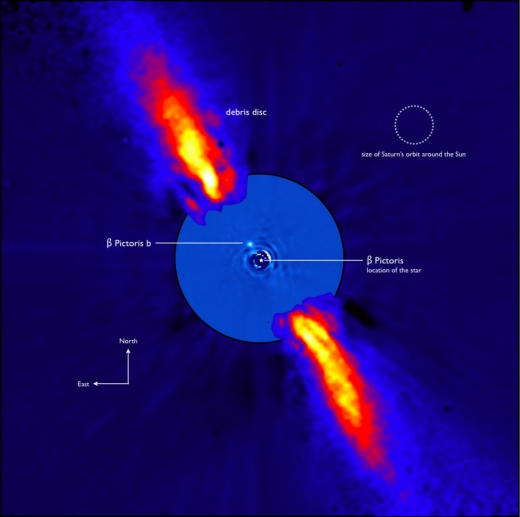
Image: The planet Beta Pictoris b is visible orbiting its host star in this composite image from the European Southern Observatory’s (ESO) 3.6-m telescope and the NACO instrument on ESO’s 8.2-m Very Large Telescope. The Beta Pictoris system is only about 20 million years old, roughly 225 times younger than the Solar System. Observing this dynamic and rapidly evolving system can help astronomers shed light on the processes of planet formation and early evolution. Credit: ESA.
Now we have what is being called the first successful estimate of a young planet’s mass taken by means of astrometry. Rather than measuring the star’s ‘wobble’ along the line of sight, as we do with radial velocity methods, the new astrometric data allow scientists to measure its deviations on the plane of the sky. Crucial to the work is a lengthy period of observation, which means taking advantage not only of data from the Gaia mission but also the older Hipparcos mission. The latter observed Beta Pictoris 111 times between 1990 and 1993.
Gaia’s second data release includes 22 months of observations, including 30 observations of Beta Pictoris. The combined measurements, examined by Ignas Snellen and Anthony Brown (Leiden University, The Netherlands) show the star’s long-term proper motion. Essentially, the scientists have measured the deviation from what would have been expected of a star without a planet, interpolating the mass of the planet from the size of this deviation.
“By combining data from Hipparcos and Gaia, which have a time difference of about 25 years, you get a very long term proper motion,” adds Brown. “This proper motion also contains the component caused by the orbiting planet. Hipparcos on its own would not have been able to find this planet because it would look like a perfectly normal single star unless we had measured it for a much longer time. Now, by combining Gaia and Hipparcos and looking at the difference in the long term and the short term proper motion, we can see the effect of the planet on the star.”
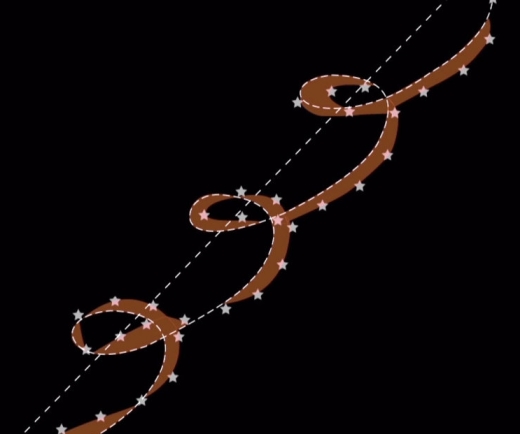
Image: Astronomers can measure the mass of exoplanets by looking at tiny deviations in the trajectories of their host stars caused by the gravitational pull of the orbiting planets. These can be observed either along the line of sight, looking for small changes in a star’s radial velocity, or on the plane of the sky, using astrometric measurements. To be able to make accurate assessments, the astrometric observations need to cover a period of many years. In this picture, the white dashed spiral shows the evolution of a star’s trajectory observable from the Earth, caused by the combination of parallax and proper motion. The brown band shows the range of deviations of the star’s trajectory caused by a possible planet orbiting it. Credit: ESA.
We learn from all this that Beta Pictoris b is a gas giant of between 9 and 13 times the mass of Jupiter. Useful in itself, the finding also highlights what we can expect from Gaia in the years ahead. Thousands of exoplanets are expected to be discovered in the course of the mission, but the tiny astrometric wobbles being sought can only be detected over sufficiently long periods of time, which is why the windfall of Gaia planets isn’t expected until late in the mission.
As to where this work fits in on the spectrum of young exoplanet studies, we see in Beta Pictoris b and other examples of young gas giants the chance to study the formation and evolution of such worlds. Thus far we have had no reliable mass measurements to distinguish between different formation models. The new Beta Pictoris b work implies a planet that has formed from gravitational instability, with disk gas collapsing to form the planet. Such a mechanism, with the infant giant planet retaining most of it initial entropy, is sometimes called a ‘hot start.’
The authors go on to point out that the collection of data leading to mass measurements for other young gas giants will help to constrain other models of early planetary evolution.
The paper is Snellen & Brown, “The mass of the young planet Beta Pictoris b through the astrometric motion of its host star,” Nature Astronomy 20 August 2018 (abstract).

